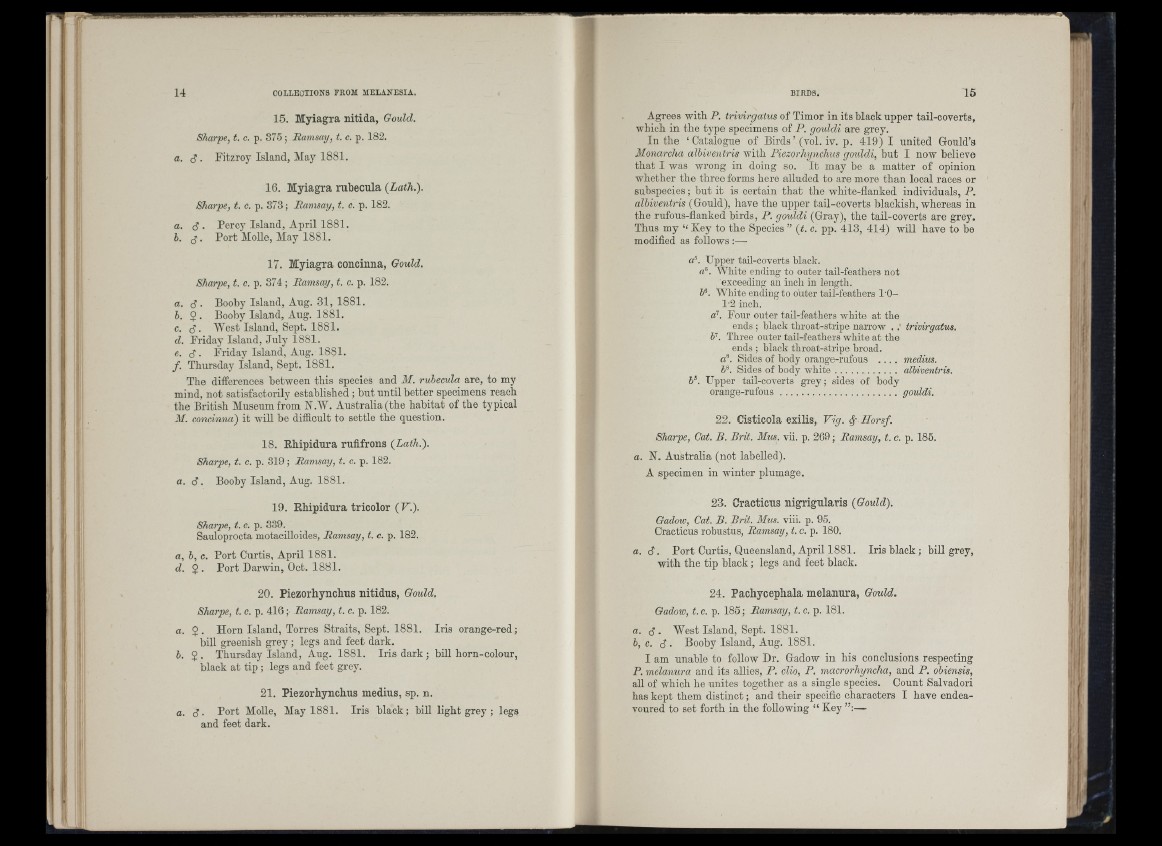
15. Myiagra nitida, Gould.
Sharpe, t. c. p. 375; Ramsay, t. c. p. 182.
a. S ■ Fitzroy Island, May 1881.
16. Myiagra rubecula {Lath.).
Sharpe, t. c. p. 373; Ramsay, t. c. p. 182.
a. cJ . Percy Island, April 1881.
I. Port MoUe, May 1881.
17. Myiagra concinna, Gould.
Sharpe, t. c. p. 374 ; Ramsay, t. c. p. 182.
а. S . Booby Island, Aug. 31, 1881.
б. $ . Booby Island, Aug. 1881.
c. c?. AVest Island, Sept. 1881.
d. Friday Island, July 1881.
e. c?. Friday Island, Aug. 1881.
f . Thursday Island, Sept. 1881.
The differences between this species and M. ruhecula are, to my
mind, not satisfactorily established ; hut until better specimens reach
the British Museum from N.AV. Australia (the habitat of the typical
M. concinna) it wiU be difficult to settle the question.
18. Ehipidnra rufifrons {Lath.).
Sharpe, t. c. p. 319 ; Ramsay, t. c. p. 182.
a. <5. Booby Island, Aug. 1881.
19. Ehipidnra tricolor (F.).
Sharpe, t. c. p. 339.
Sauloprocta motacilloides, Ramsay, t. c. p. 182.
a, h, c. Port Curtis, April 1881.
d. 2 . Port Darwin, Oct. 1881.
20. Piezorhynchus nitidus, Gould.
Sharpe, t. c. p. 416 ; Ramsay, t. c. p. 182.
а. 2 . Horn Island, Torres Straits, Sept. 1881. Iris orange-red ;
bill greenish grey ; legs and feet dark.
б. 2 • Thursday Island, Aug. 1881. Iris dark ; bill horn-colour,
black at tip ; legs and feet grey.
21. Piezorhynchus medius, sp. n.
O. c?. Port Molle, May 1881. Iris black; biU light grey ; legs
and feet dark.
!Hi
Agrees with P. trivirgatus of Timor in its black upper tail-coverts,
which in the type specimens of P. gouldi are grey.
In the ‘Catalogue of Birds’ (vol. iv. p. 419) I united Gould’s
Monarcha albiventris with Piezorhynchus gouldi, but I now believe
that I was wrong in doing so. I t may be a matter of opinion
whether the three forms here alluded to are more than local races or
subspecies ; but it is certain th at the white-flanked individuals, P.
albiventris (Gould), have the upper tail-coverts blackish, whereas in
the rufous-flanked birds, P. gouldi (Gray), the tail-coverts are grey.
Thus my “ Key to the Species” {t. c. pp. 413, 414) will have to he
modified as follows :—
a®. Upper tail-coverts black.
rt®. White ending to outer tail-feathers not
exceeding an inch in length.
V. White ending to outer tail-feathers I ’O-
1'2 inch.
o’. Four outer tail-feathers white at the
ends ; black throat-stripe narrow . . trivirgatus.
V . Three outer tail-feathers white at the
ends ; black throat-stripe broad,
a®. Sides of body orange-rufous . . . . medius.
W. Sides of body w h ite ...................... albiventris.
h°. Upper tail-coverts grey ; sides of body
orange-rufous...........................................gouldi.
22. Cisticola cxilis, Vig. ^ Horsf.
Sharpe, Cat. B. Brit. Mus. vii. p. 269; Ramsay, t. c. p. 185.
a. N. Australia (not labelled).
A specimen in winter plumage.
23. Cracticus nigrigularis {Gould).
a.
Gadoto, Cat. B. Brit. Mus. viii. p. 95.
Cracticus robustus, Ramsay, t. c. p. 180.
6 . Port Curtis, Queensland, April 1881.
with the tip b lack; legs and feet black.
Iris black ; biU grey,
24. Pachycephala melanura, Gould.
Gadoio, t. c. p. 185; Ramsay, t. c. p. 181.
a. c? . AYest Island, Sept. 1881.
h, c. (S . Booby Island, Aug. 1881.
I am unable to follow Dr. Gadow in his conclusions respecting
P. melanura and its allies, P. clio, P. macrorhyncha, and P. ohiensis,
all of which he unites together as a single species. Count Salvador!
has kept them distin ct; and their specific characters I have endeavoured
to set forth in the following “ Key —